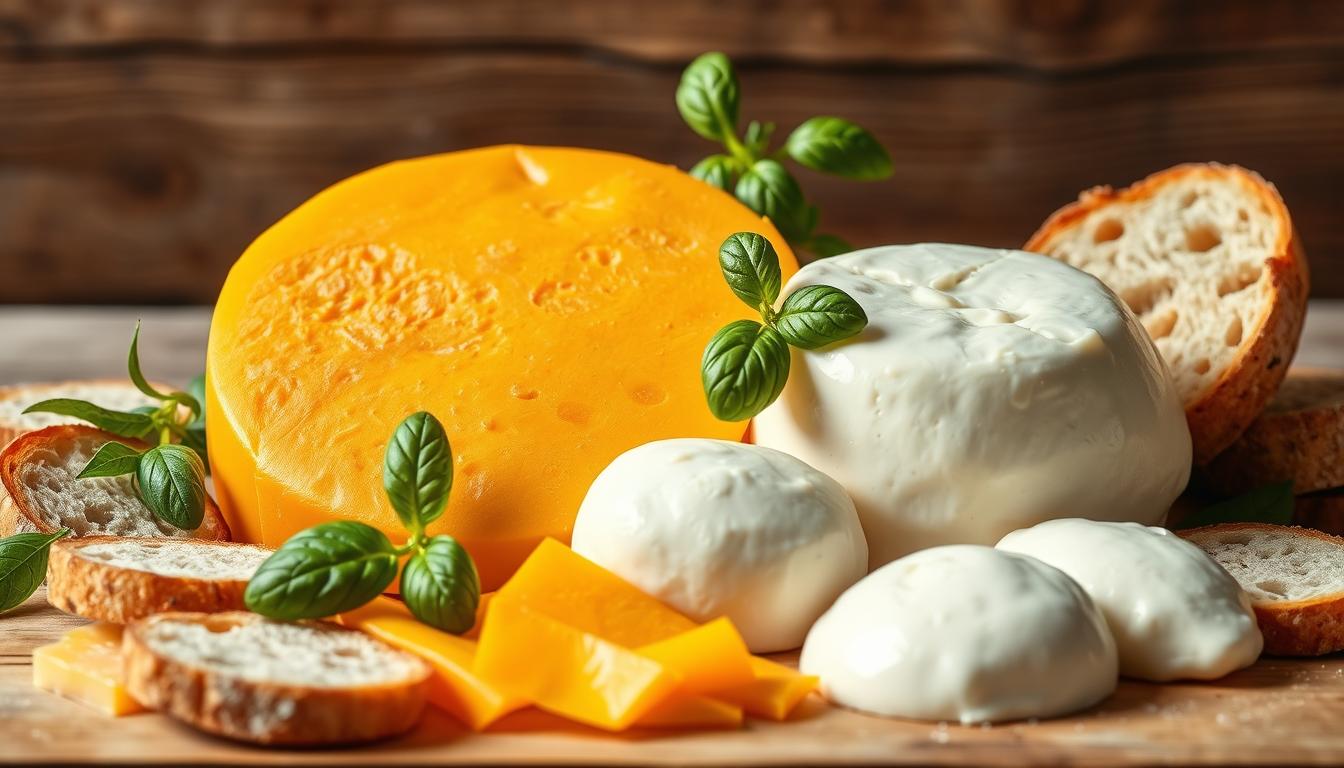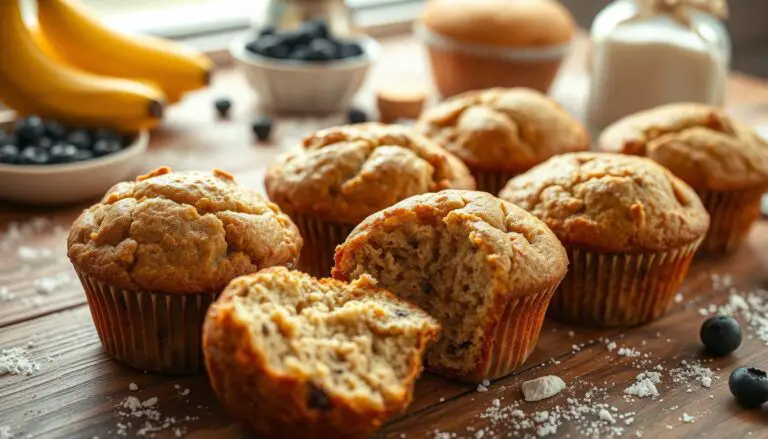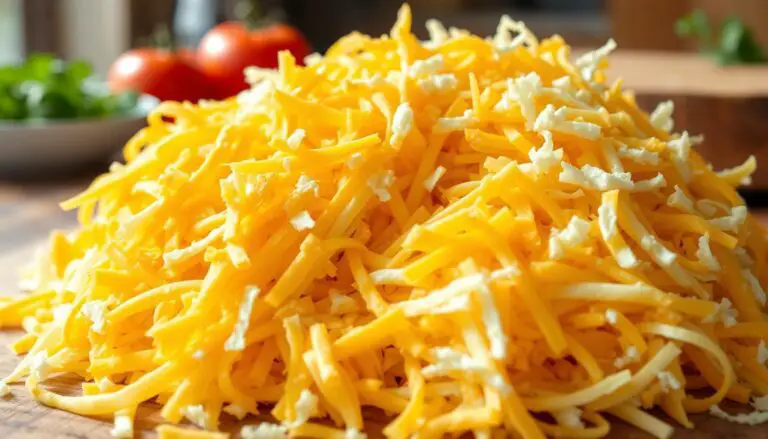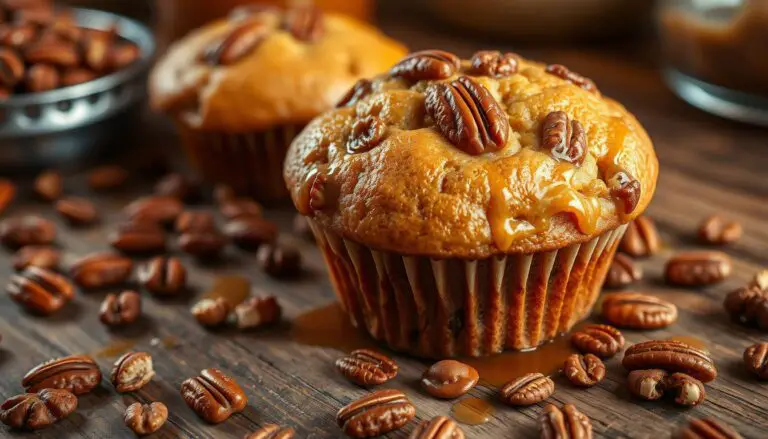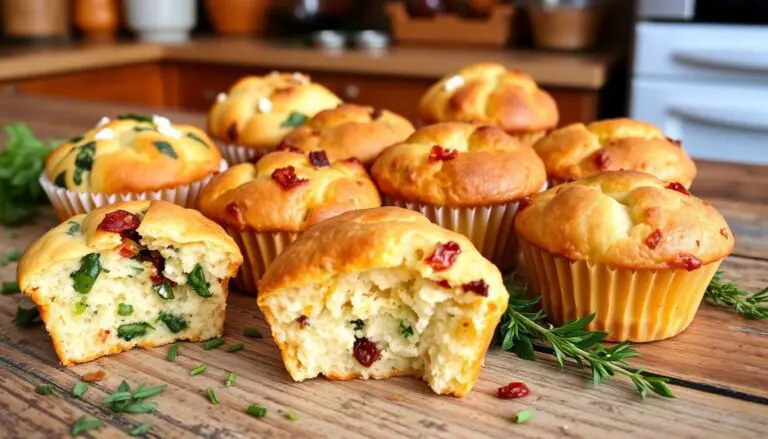Cheddar vs. Mozzarella: Cheese Comparison Guide
Ever thought about the nutritional benefits of your favorite melted cheese? Cheddar and mozzarella are two of the most loved cheeses globally. Knowing their differences can help you make better food choices. This guide explores their unique traits, textures, tastes, and uses in cooking.
Key Takeaways
- Cheddar cheese comes in many flavors, from young to aged.
- Mozzarella is a lower-calorie choice, with 64kcals per 25g1, and less saturated fat than cheddar.
- Both cheeses are good sources of calcium, with cheddar offering 185mg per 25g2.
- Cheddar’s cheddaring process makes its flavors more complex.
- Mozzarella is great for melting and is used in many dishes.
Introduction to Cheddar and Mozzarella
Cheddar cheese and mozzarella cheese are loved by many worldwide. They have unique tastes and textures, making them key in many dishes. Cheddar, from England, is known for its sharpness and comes in various strengths. Mozzarella, from Italy, is creamy and mild, great for pizzas and salads.
The cheese production for both involves careful steps. For cheddar, high-quality milk is essential. It’s recommended to use about six gallons of raw milk at the start. The milk is then heated, cultured, and mixed with rennet to coagulate the curd. The curds are cut and pressed to get the final product3.
Mozzarella has been made since the 16th century, mainly from cow’s milk. But, authentic mozzarella di bufala comes from water buffalo’s milk, especially in Italy. The cheese’s moisture level changes its melting properties. Mozzarella’s special trait is its stretchy and oozing quality when melted, thanks to its casein proteins4.
Learning about cheddar and mozzarella helps us appreciate their uses in cooking. They add rich flavors and textures to our dishes, whether in cheese sauces or on pizzas. This knowledge deepens our enjoyment of these cheeses.
Difference Between Cheddar and Mozzarella Cheese
Cheddar and mozzarella cheese differ in many ways, like nutrition, texture, and taste. These differences can change how we cook and what we eat.
Nutritional Comparison
It’s important to know the nutritional differences between cheddar and mozzarella. Cheddar has more calories and fat, especially when it’s aged over 12 months. This makes it firmer5. Mozzarella, being a fresh cheese, has fewer calories and less saturated fat. This makes it a good choice for those watching their diet6. There are also low-fat mozzarella options for even healthier choices.
Texture and Flavor Profiles
Cheddar and mozzarella have different tastes and textures. Cheddar has a sharp, tangy flavor that gets stronger with age, up to two years for the extra sharp kind6. Mozzarella tastes mild and slightly tangy, perfect for many dishes. Mozzarella is also known for its stretchy texture, great for pizzas and lasagnas5. Cheddar, on the other hand, is crumbly, especially when aged, making it good for sandwiches and sauces7.
| Cheese Type | Origin | Typical Aging | Flavor Profile | Texture |
|---|---|---|---|---|
| Cheddar | England | 12 months to 2 years | Sharp, tangy | Slightly crumbly |
| Mozzarella | Italy | Fresh | Mild, slightly tangy | Smooth, elastic |
Cheddar Cheese: An Overview
Cheddar cheese is loved worldwide for its unique taste and flexibility. It comes from Cheddar village in Somerset, England, dating back to the 12th century8. It’s mainly made from cow’s milk, but goat’s or sheep’s milk is used in some types8.
Production Process
Cheddar cheese making starts with pasteurizing cow’s milk to kill off bad bacteria. The milk’s fat content is then standardized. Next, enzymes or rennet are used to coagulate the milk, followed by scalding and cutting the curds.
The Cheddaring technique is key, where curds are stacked and turned to create texture. After that, the curds are salted and pressed into molds, ready for aging9.
Aging Process
The aging process greatly affects cheddar cheese’s taste and texture. It can last from a few months to several years, enhancing its sharpness and flavor8. For instance, sharp cheddar ages over a year, giving it a stronger taste. Mild cheddar, on the other hand, is younger and milder9.
During aging, compounds like γ-glutamyl dipeptides increase, adding to the flavor9. Some cheddar cheeses are even studied for their amino acids and flavors to improve cooking9.
| Aging Duration | Flavor Profile | Texture |
|---|---|---|
| 0-3 Months | Mild | Soft and Creamy |
| 4-12 Months | Medium | Slightly Crumbly |
| 1-2 Years | Sharp | Firm and Crumbly |
| 3+ Years | Extra Sharp | Very Firm |
Cheddar cheese is a favorite in cooking, thanks to its consistency and quality. It’s one of the world’s most famous cheeses810.
Mozzarella Cheese: An Overview
Mozzarella cheese is key in Italian cooking. It’s made from water buffalo milk, especially in Mozzarella di Bufala Campana DOP. But, most mozzarella today comes from cow’s milk because water buffalo are rare11.
Production Process
Mozzarella making uses a special method called pasta filata. This involves stretching and kneading the curds. It’s crucial for its unique texture12.
The cheese is heated and worked on for a certain time. This affects its quality and how it melts12. There are two main types: low moisture and high moisture mozzarella. Low moisture mozzarella is common in stores, while high moisture is more perishable but tastes milder11.
Types of Mozzarella
There are many mozzarella types for different uses. Here are a few:
- Fresh Mozzarella – It has a light taste and a springy feel. It’s great in salads and caprese dishes.
- Low-Moisture Mozzarella – This melts well, making it perfect for pizzas and baked goods.
- Smoked Mozzarella – It has a smoky flavor, adding a special touch to dishes.
Mozzarella is versatile and important in many dishes. Each type has its own qualities, fitting different cooking styles and tastes11.
Cheese Varieties and Their Characteristics
Learning about different cheese types can make you appreciate cheddar and mozzarella more. Each cheese has its own special traits, shaped by aging, texture, and taste. Knowing this helps you pick the perfect cheese for your recipes.
Cheddar Cheese Varieties
Cheddar cheese comes in many flavors and textures. Here are some common ones:
- Mild Cheddar: Soft and creamy, with a mild taste.
- Sharp Cheddar: Has a stronger flavor, perfect for adding depth.
- Extra Sharp Cheddar: Has a bold, tangy taste for those who love strong cheese.
Cheddar cheese is made through a special process using rennet and controlled temperatures. This affects its taste and texture13. Aged cheddar has complex flavors, great for fancy recipes.
Mozzarella Cheese Varieties
Mozzarella cheese is mainly split into fresh and low-moisture types:
- Fresh Mozzarella: Soft and moist, perfect for salads and caprese.
- Low-Moisture Mozzarella: Firmer, great for melting on pizzas.
This cheese is loved for its sweet taste and stretchy feel. It’s a key ingredient in many dishes14. Mozzarella’s unique making process keeps its quality and taste top-notch15.
Cheese Nutrition: Cheddar vs. Mozzarella
When we look at the cheese nutrition of cheddar and mozzarella, we see big differences. These differences matter a lot for people watching what they eat. It’s especially important for those who are careful about the cheese they choose.
Caloric Content Comparison
Cheddar cheese has more calories than mozzarella. Cheddar has about 114 calories per ounce. Mozzarella, on the other hand, has between 72 to 85 calories, depending on its type1617. This shows why cheddar is so popular, even though it has more calories.
Protein Levels in Each Cheese
Protein is also a key factor in comparing these cheeses. Cheddar has about 7g of protein per ounce. Mozzarella has around 6g per ounce16. This small difference can be important for those looking to get more protein from cheese.
Fat Content and Types
Looking at the cheese fat content, we see that cheddar has more fat. Cheddar has 9g of fat per ounce. Mozzarella has 6g for whole milk and 4.5g for part-skim1617. Knowing this helps us understand how these cheeses fit into a healthy diet. It’s especially important for those watching their fat intake.
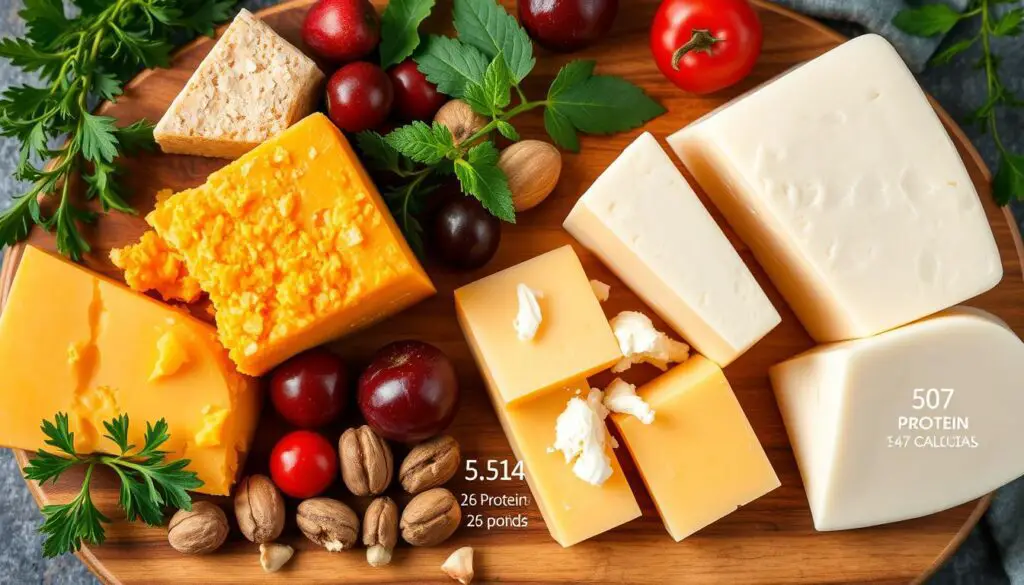
Health Benefits of Cheddar and Mozzarella
Cheddar and mozzarella cheeses offer many health benefits. They are key to a balanced diet. Knowing what vitamins and minerals they have helps us make smart food choices. These cheeses are great for snacks or meals, especially for those looking for something nutritious.
Cheddar cheese is especially good for our bones because of its high calcium content.
Vitamins and Minerals Content
Cheddar cheese is known for its strong taste and has about 200 mg of calcium in a 1-ounce serving. This meets nearly one-third of the daily calcium needs for adults aged 19-5018. It also has protein and other nutrients important for our bodies.
Mozzarella cheese also has its benefits, with about 143 mg of calcium per ounce, which is 10% of the daily value19. Whole-milk mozzarella has 85 calories, 6 grams of protein, and good probiotics for our gut health19.
Heart Health Considerations
Eating dairy, like cheese, may help lower the risk of heart disease18. Cheddar cheese has saturated fat, with one ounce giving 5 grams, which is over a third of what an adult should have daily20. Mozzarella, especially the part-skim type, has a better fat balance and less sodium, which is good for the heart19.
The guidelines for dairy suggest keeping salt intake low for heart and blood pressure health18. Cooking mozzarella sticks in an air fryer can make them a healthier part of a diet.
| Cheese Type | Calcium (mg) | Protein (g) | Saturated Fat (g) | Sodium (mg) |
|---|---|---|---|---|
| Cheddar (1 oz) | 200 | 7 | 5 | 180 |
| Mozzarella (1 oz) | 143 | 6 | 4 | 138 |
Understanding the health benefits of cheese, like cheddar and mozzarella, helps us make better choices. Adding these cheeses to our meals can bring flavor and nutrition together.
Culinary Uses: Cheddar vs. Mozzarella
Cheddar and mozzarella are both great in many dishes. They add unique tastes and textures. Knowing when to use each can make your cooking better.
Best Dishes for Cheddar
Cheddar is perfect for comfort foods and big meals. Here are some favorites:
- Macaroni and Cheese: Cheddar’s sharp flavor makes this dish special.
- Grilled Cheese Sandwich: A classic that shows off cheddar’s meltiness.
- Cheddar Cheese Soup: It’s a cozy meal with melted cheddar adding richness.
- Cheese Sauce: Great for nachos or veggies, cheddar melts smoothly21.
Best Dishes for Mozzarella
Mozzarella is famous for melting well and is key in Italian food. Here are some top picks:
- Pizza: Mozzarella’s gooey texture is a must for pizza.
- Lasagna: It’s a key ingredient for layers of pasta and cheese.
- Caprese Salad: Fresh mozzarella adds creaminess to this salad.
- Stuffed Chicken: Mozzarella makes melty pockets in chicken dishes21.
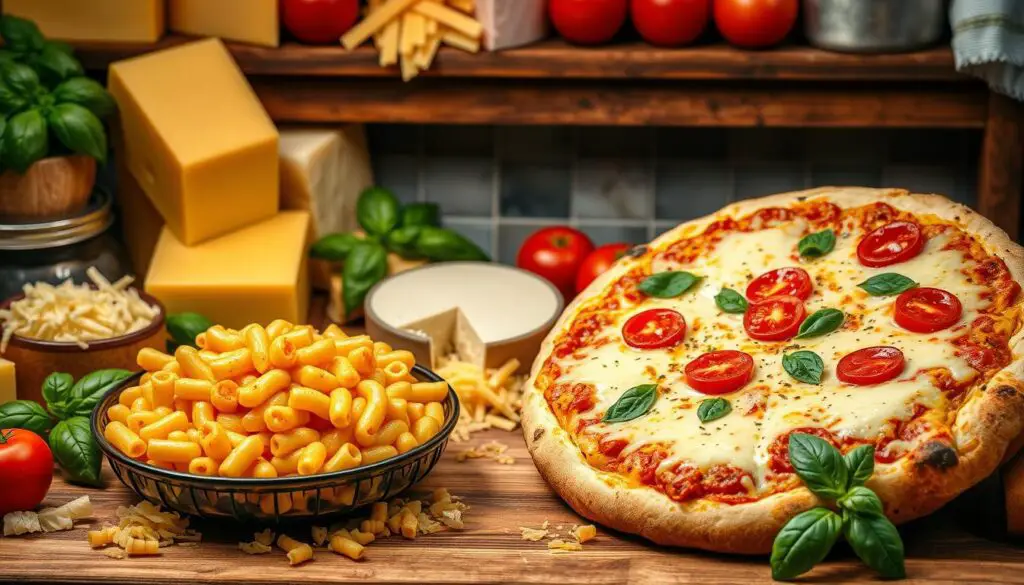
Choosing between cheddar and mozzarella depends on your dish. Cheddar has a strong taste, while mozzarella is soft and creamy. Both are essential for exploring flavors in cooking2223.
Popular Recipes Featuring Cheddar and Mozzarella
Exploring cheddar cheese and mozzarella cheese recipes reveals a world of flavors. Cheddar soups warm the heart, while mozzarella pizzas excite the taste buds. These dishes show how versatile these cheeses are, making meals unforgettable.
Delicious Cheddar Recipes
Cheddar cheese soup is a favorite for cold nights. It uses 6 gallons of raw milk, or a 3-gallon version for home use. The milk is heated to 86F, then cultured for 90 minutes for flavor.
After adding rennet and cooking the curds, the cheese is pressed and aged. This step is crucial for the cheddar’s unique taste24.
Delicious Mozzarella Recipes
Mozzarella cheese fans will love homemade mozzarella sticks or caprese salad. A quick homemade pizza is also a hit, ready in 15 minutes for up to four people25. Check out more mozzarella recipes to spice up your meals. Mozzarella’s creaminess pairs well with fresh ingredients, making any dish special.

